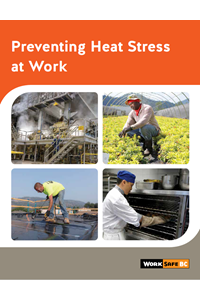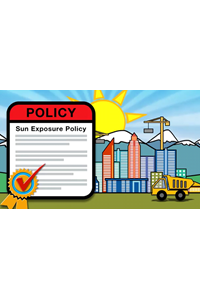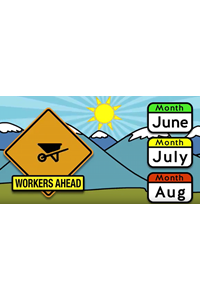Heat stress
Our bodies naturally maintain a temperature between 36°C and 38°C. Sweating cools our bodies down, but if you work in a hot environment this might not be enough. If your body heats up faster than it can cool itself, you experience heat stress. This can lead to serious heat disorders and potential injury.
- How workers are exposed
- The dangers to workers
- How to protect workers
- Resources
How workers are exposed
There are three main causes of heat stress. They are:
| The environment |
|
| The work |
|
| The worker |
|
The dangers to workers
As a worker's body heats up it loses fluids and salt through sweat. As workers dehydrate they are less able to cool themselves down. Workers in a hot environment should be aware of these warning signs of heat stress:
- Excessive sweating
- Dizziness
- Nausea
If heat stress is not recognized and treated early, it can lead to heat disorders, which have serious effects on the body. These include:
| Heat cramps |
|
| Heat exhaustion |
|
| Heat stroke |
|
How to protect workers
The most effective way to reduce the risk of heat stress is to eliminate the source of exposure. If that's not possible, there are other risk controls to use. When choosing risk controls, start by asking yourself the questions in the following steps, which are listed in order of effectiveness.
-
1
Elimination or substitution
Eliminating the hazard by substituting a safer process or material, where possible, is the most effective control. A question to consider:
- Can the job be done in a cooler environment?
-
2
Engineering controls
Making physical modifications to facilities, equipment and processes can reduce exposure. Some questions to consider:
- Can ventilation be improved?
- Can hot surfaces be insulated or covered to reduce radiant heat?
- Can shields and barriers be installed to protect workers from heat?
- Can humidity be reduced?
-
3
Administrative controls
Changing work practices and work policies, awareness tools, and training can limit the risk of heat stress. Some questions to consider:
- Can warning signs be posted in the work area?
- Can cool-down rooms be provided?
- Can workers be acclimated to heat?
- Can water be provided?
-
4
Personal protective equipment
This is the least effective control. It must always be used in addition to at least one other control. Some questions to consider:
- Do workers have heat-reflective clothing or water-cooled suits?
- Has personal protective equipment been tested to make sure it is working properly?



